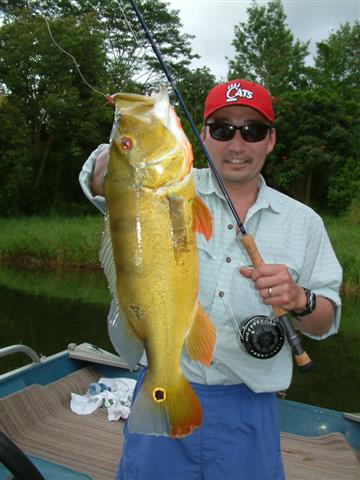Tukes on the Fly
Posted: Fri Jun 09, 2006 9:49 am
Randall Sakai was in town last week for a graduation so we decided to grab our fly rods and relax for a few hours on Wahiawa Reservoir. The action was slow as we cursed along the shore line blind casting around brush piles for peacock bass. We caught a few small ones and had several more chase. Even the Red Devils were not very aggressive.
We were working only 20 or 30 feet from shore when I snagged a bush and had to go in close to retrieve my fly. That's when we spotted 4 big peacocks guarding nests in one foot of clear water. I backed the boat out a ways, and Randall laid his fly just beyond the larger of the fish. As the fly (a weighted Crazy Charlie looking thing tied with white/red polar bear hair) dropped into the nest the fish attacked with a vengeance.
We went round and round for several minutes, I trying to position the boat and Randall trying to keep the fish from getting tangled in the underwater brush. The fish won. It had to have been over 6 pounds. (but then everyone knows that any fish that breaks the line is always "over 10".
We decided right then to try another technique. Standing in the bow of the boat we used the electric trolling motor to move along the shore looking for the nests of spawning fish. It didn't take long. I wonder how many fish we had bypassed earlier? So now the action picked up as we spotted a pair of spawners, repositioned the boat, and cast our flys to the male fish (the larger of the two fish guarding the nest.) It's really fun to see the fish your casting to and watch it turn and grab the fly. It's also not as easy as it sounds. You have to make an accurate cast and set the hook when the fish strikes. Lots of times a fish will just "blow" the fly out of the way. Other times it grabs the fly, moves a few feet from the nest, and spits it out. This happens so quickly you can't even see it. I've seen people make 30 casts into a nest and never hook the fish. Fishing for peacock bass on a nest may not be that easy, but it sure is exciting.
Aloha,
Stan

Randall Sakai with a 4# peacock caught on his newest Polar Bear Hair Crazy Charlie.
We were working only 20 or 30 feet from shore when I snagged a bush and had to go in close to retrieve my fly. That's when we spotted 4 big peacocks guarding nests in one foot of clear water. I backed the boat out a ways, and Randall laid his fly just beyond the larger of the fish. As the fly (a weighted Crazy Charlie looking thing tied with white/red polar bear hair) dropped into the nest the fish attacked with a vengeance.
We went round and round for several minutes, I trying to position the boat and Randall trying to keep the fish from getting tangled in the underwater brush. The fish won. It had to have been over 6 pounds. (but then everyone knows that any fish that breaks the line is always "over 10".
We decided right then to try another technique. Standing in the bow of the boat we used the electric trolling motor to move along the shore looking for the nests of spawning fish. It didn't take long. I wonder how many fish we had bypassed earlier? So now the action picked up as we spotted a pair of spawners, repositioned the boat, and cast our flys to the male fish (the larger of the two fish guarding the nest.) It's really fun to see the fish your casting to and watch it turn and grab the fly. It's also not as easy as it sounds. You have to make an accurate cast and set the hook when the fish strikes. Lots of times a fish will just "blow" the fly out of the way. Other times it grabs the fly, moves a few feet from the nest, and spits it out. This happens so quickly you can't even see it. I've seen people make 30 casts into a nest and never hook the fish. Fishing for peacock bass on a nest may not be that easy, but it sure is exciting.
Aloha,
Stan

Randall Sakai with a 4# peacock caught on his newest Polar Bear Hair Crazy Charlie.